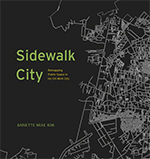Sidewalk City: Remapping Public Space in Ho Chi Minh City

Sidewalk City is devoted to a part of the urban landscape that is often overlooked. Its author, Annette Miae Kim, teaches public policy and directs the Spatial Analysis Lab at the University of Southern California. She points out that it is through sidewalks that most people engage with the built environment; access to buildings is restricted and not everyone drives, but nearly everyone comes into contact with sidewalks. This is particularly true of Ho Chi Minh City (HCMC), whose sidewalks were built under the French colonial regime but have been reshaped in multiple ways since then: from colonial to postcolonial nationalist, socialist and market transition (including the importance of migration).
The book details the multiple benefits of seeing a sidewalk as a mixed-use public space. Sidewalks are meeting places and thus spaces for democratic engagement. They are also sites of commerce for lower-income people.
It is troubling, then, that HCMC officials have undertaken sidewalk clearance policies. This has disproportionately affected street vendors and lower-income people in general, who have less private space of their own. This is part of a larger drive to turn HCMC into a “modern, world-class city”, in which sidewalks are passages for movement rather than venues of activity in their own right.
Methodologically, Kim uses “spatial ethnography” to examine “everyday urbanism”. The rationale is that physical space and social space should be viewed together in analysis that is grounded in lived reality at the local level. Otherwise the risk is of subscribing to idealized design practices that are well out of alignment with actual conditions, such as upgrading programmes whose sanitation infrastructure is too large for people’s homes and actually leads to water-borne disease. Practically, Kim’s spatial ethnography involves participant observation and interviews in situ, as well as an openness to reconceptualizing units of analysis based on the actual practices of research participants.
Kim also expands the levels of analysis to discuss the inherently political nature of mapping. This leads to an elaboration of “critical cartography”, and how more inclusive mapping can be a tool for more inclusive planning. The book uses striking images to compare conventional urban maps with alternatives that reflect in greater detail how HCMC residents use sidewalks. Some of these alternative maps are fanciful and artistic, yet in the aggregate they present a critique to the idea that there is only one (objective) manner to lay out a city. The tendril-like map showing the locations where street vending is legally allowed, for instance, highlights the divergence between formal and informal practices.
Kim is interested in calling not just for new analytical lenses, but for ways to apply them to legitimizing sidewalk life. The example in Sidewalk City is of the tourist path and map she and her colleagues proposed to local officials. Their idea was to use HCMC’s inevitable tourism to guide recognition of sidewalk street vendors and promote pedestrianism. This tourist pedestrian path is an example of Kim’s approach to scholarship: one that is inseparable from advocacy.
Further reading:
Banerjee, Tridib (2001), “The Future of Public Space: Beyond Invented Streets and Reinvented Places”, Journal of the American Planning Association Vol 67, No 1, pages 9–24, available at https://chisineu.files.wordpress.com/2013/03/the-future-of-public-space.pdf.
Loc, Nguyen Thi Tan, Le Nhu Thinh, Le Thi Ha and Paule Moustier (2013), “Inclusive urban development? Making space for street vending in Hanoi, Vietnam”, Sustainable Markets working paper, International Institute for Environment and Development, London, 40 pages, available at http://pubs.iied.org/16534IIED.html?k=vendor.
Malone, Karen (2002), “Street life: youth, culture and competing uses of public space”, Environment and Urbanization Vol 14, No 2, pages 157–168, available at http://eau.sagepub.com/content/14/2/157.abstract.
Book note prepared by Christine Ro
Search the Book notes database
Our Book notes database contains details and summaries of all the publications included in Book notes since 1993 - with details on how to obtain/download.
Use the search form above, or visit the Book notes landing page for more options and latest content.
For a searchable database for papers in Environment and Urbanization, go to http://eau.sagepub.com/

